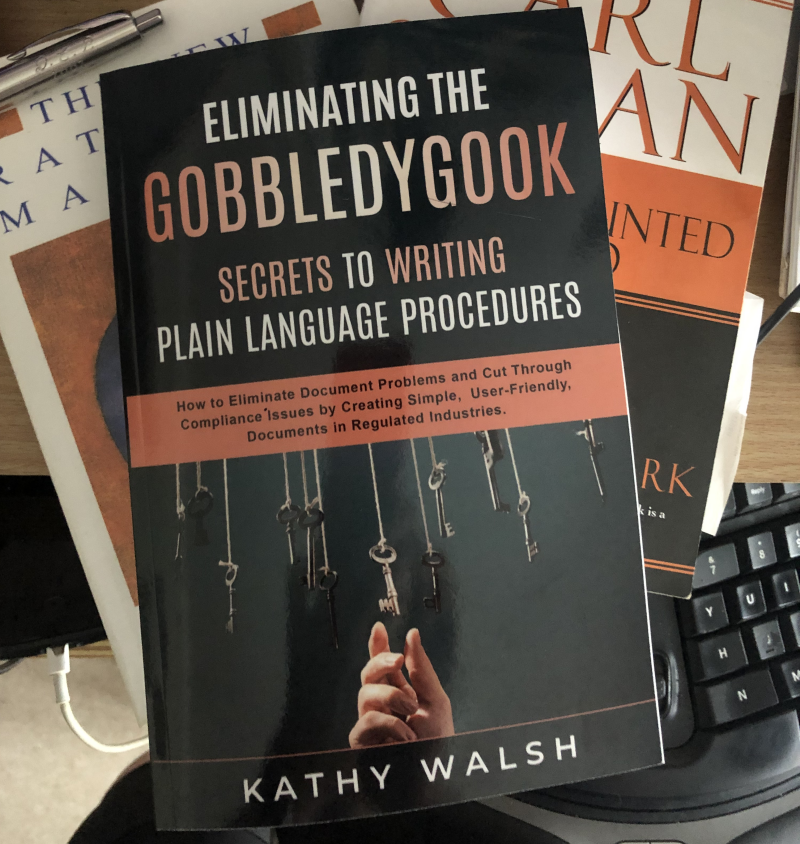As one with a love for documentation and trying to communicate effectively and concisely, I bought a copy of Eliminating the Gobbledygook – Secrets to Writing Plain Language Procedures by Kathy Walsh. I am pretty sure I worked alongside Kathy some years back on what was called the Documentation Effectiveness Project at Mayne so I was not expecting too many surprises as we both know our stuff. The purpose of the book purchase was to refresh and update my knowledge of controlled document writing. I figured I may as well review the book in the process.
I was unaware that Plain Writing was a movement – I thought that was just how things were done. It is certainly how I was trained to write technical documents.
Eliminating the Gobbledygook, Secrets to Writing Plain Language Procedures is structured logically and follows the following pattern for each chapter:
- introduction
- contents
- summation
- what comes next
- review questions / points to ponder
This mirrors the way I was taught to train small groups.
There are three main sections to the book:
- About plain language
- Writing in plain language
- Developing a plain language Quality Management System (QMS)
While reading the book, I made notes on how certain aspects could be applied to my blogging as well as my presentations. It was comforting to note that in my current job as a technical support engineer, I use my writing skills to provide instructions primarily in an imperative style. It was also nice to see the overall concepts of document writing presented in the book were familiar to me. I was a little surprised that those with industry knowledge and technical witting skills are rare. This is a skill-set of mine I will start emphasizing.
Reading Eliminating the Gobbledygook, Secrets to Writing Plain Language Procedures was quite easy, demonstrating Kathy applies her own rules to her writing: A well written document or book is easy and fast to read. I knocked off part one in under a day of interrupted reading. Part 2 took me about a week of interrupted reading. Part 3 took an afternoon to complete.
| Note: As I am familiar with the content, my reading and comprehension time may have been faster than a casual reader. |
Controlled and managed documents were differentiated which is an important distinction to make when it comes to your QMS.
Much of the information is “chunked” into tables and bullet points, which reflects an acceptable way of writing a SOP or OI.
Document scoping and assessing impact was discussed. I cannot explicitly remember doing that when I updated or wrote documents. It may have been something I just did. e.g. considering what other processes might be impacted, the training that might need to be developed or delivered and what other documents might need to be updated or references altered in. In any event, scoping your changes and conducting an impact assessment is great advice.
Helpful tables listing key ideas and showing examples were provided throughout the book.
Chapter 11 directs the reader to consider the audience when using italics. As a microbiologist, my recommendation is to always use italics when naming microbes as it is the correct way of doing things. This chapter also touches on style guides. Having completed a Visual Communication diploma*, I agree that style guides should be specific to marketing and branding collateral – the flashy documents. Your controlled and managed documents should be utilitarian and to the point.
One section I liked and you could find valuable is the one titled Avoid Worthless Changes and Time wasting (pg146/214). I am a big fan of being efficient and detest the seemingly endless review cycle that can form between the writing and verification stages.
There were a few typos. That may look bad in a document talking about accurate documentation. Having written and reviewed 100’s of documents, even after espousing my attention to detail I always find at least one typo.
Eliminating the Gobbledygook, Secrets to Writing Plain Language Procedures, will be a great addition to my reference library. It could be for you too.
*When I completed my diploma, Visual Communication was called Graphic Design.

